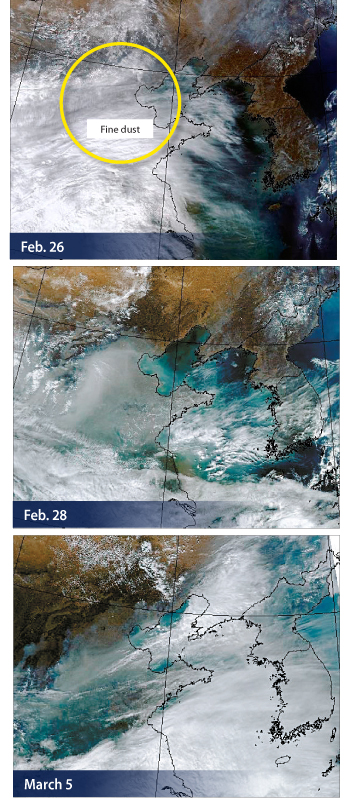Pollution migration can be spotted by satellites
The National Aeronautics and Space Administration (NASA) satellite images captured fine dust particles moving from China to Korea during the week when the local air pollution levels hit records earlier this month.
NASA satellite images taken on Feb. 26, Feb. 28 and March 5 show that fine dust particles moved from China to Korea. According to the satellite images, the skies over the Korean Peninsula were clear on Feb. 26, but fine dust particles began to shroud the peninsula on Feb. 28 and completely cover it on March 5. [KOREA METEOROLOGICAL ADMINISTRATION]
In Seoul, fine dust alerts were issued every day from Feb. 28 to March 7. Alerts are issued when the hourly average of PM2.5 particles is higher than 75 micrograms for more than two hours.
PM2.5 particles are less than 2.5 micrometers in diameter and about 30 times smaller than the width of a human hair. The World Health Organization (WHO) describes them as carcinogenic since PM2.5 particles can travel through the respiratory tract and reach the bloodstream, causing lung cancer and other lung problems as well as heart issues and strokes. The WHO recommends daily exposure to no more than 25 micrograms of PM2.5 particles. The PM2.5 level in Seoul broke the record on March 5, hitting 135 micrograms, the highest since 2015, when data was first recorded.
The footage from NASA was corroborated by satellite images from South Korea’s Chollian satellite collected by Kim Jhoon, a professor of atmospheric sciences at Yonsei University, which showed fine dust particles moving east from the Beijing area from March 4 to 7. According to the data collected by Kim and his team, the fine dust concentration was higher in the western regions of Korea than in the eastern regions earlier that week.
But it will not be enough evidence for the Chinese government, said one expert.
“This is how I understand China sees the issue: that satellite images are taken from space, which means that they cannot tell how low or high the fine dust particles were traveling in the atmosphere,” an air quality expert told the JoongAng Ilbo. “With this reasoning, China will say that the footage does not prove that the fine dust particles were traveling at an atmospheric level that affects the air quality.”
Chinese Foreign Ministry’s spokesperson Lu Kang asked in a press conference on March 6 if South Korea was “sure if their pollution is from China,” adding that the causes could be various and complicated.
Following his statement, hundreds of Koreans filed petitions to the Blue House asking the Moon Jae-in administration to confront the Chinese government about fine dust.
Many Koreans believe that emissions from Chinese factories on its eastern shores have a lot to do with the deteriorating air quality in Korea.
Studies have put out varying results. A joint study between NASA and South Korea’s Environment Ministry’s National Institute of Environmental Research (NIER) in May and June 2016 said that 52 percent of the air pollutants in the country were found to have been produced locally, while 48 percent were attributed to external factors - with 34 percent coming from China.
A more recent study by NIER said a majority of the air pollution on severely polluted days from 2015 to 2017 was caused by inflows of foreign pollutants and stagnant air.
The JoongAng Ilbo looked into whether the alleged movement of fine dust particles from China into Korea, as described in some NASA footage, could be corroborated with PM2.5 levels. And it found at least one example.
In 2014, NASA uploaded two satellite photos on its website showing images taken over China and Korea. One was an image taken on Feb. 20, 2014. NASA said the air pollutants were limited to the northern areas of China on this day. Then in uploading another photo taken on Feb. 25, 2014, NASA said that the pollutants had traveled to hover over the Korean Peninsula, the East Sea and Japan.
The PM2.5 level in Beijing from Feb. 24 to 25 peaked at 444 micrograms. The daily average PM2.5 level in Seoul was 35 micrograms on Feb. 21, but it rose to 51 micrograms on Feb. 22 and to 86 micrograms on Feb. 25.
BY KANG CHAN-SU [chung.juhee@joongang.co.kr]










with the Korea JoongAng Daily
To write comments, please log in to one of the accounts.
Standards Board Policy (0/250자)